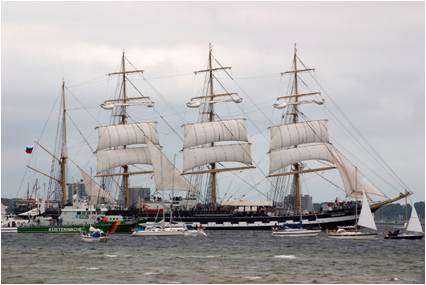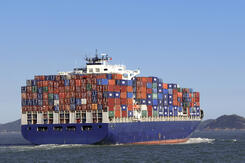Will May Container Line Contracts Spell Shipping Success for 2013?
May 1st is a big day for international shipping carriers’ eastbound trans-Pacific container lines.
Bill Mongelluzzo, Senior Editor for the Journal of Commerce (JOC) compares it to a race, calling May 1st the finish line for the container lines to sign service contracts with their customers.
 It’s hard for me to think of the container lines with their slow steaming ships crawling across the ocean to save fuel (and reduce their carbon footprint) as a race when there used to be a very literal race in the international shipping industry. In the1800’s, cargo vessels literally raced each other across the ocean to be the first to deliver their cargo of tea between Britain and China.
It’s hard for me to think of the container lines with their slow steaming ships crawling across the ocean to save fuel (and reduce their carbon footprint) as a race when there used to be a very literal race in the international shipping industry. In the1800’s, cargo vessels literally raced each other across the ocean to be the first to deliver their cargo of tea between Britain and China.
Check out our blog on “the Great Tea Race of 1866”.
The winner of the international shipping race back then received larger profits for beating the rest of the competition. While it doesn’t hold the visual excitement of ships sailing across the ocean at their top speeds, giving everything they’ve got to beat all the other cargo vessels, the race Mongelluzzo describes also holds a prize of increased profits at the finish line.
The victory carriers’ eastbound trans-Pacific container lines are looking for are increased contract rates, even if modest, from 2012.
Getting increased contract rates is “critical this year because carriers suffered from rates that barely broke even or, worse, lost them money,” says Mongelluzzo.
These contracts, it’s important to note, are with the “big boy shippers”. We’re talking your Walmart types, who ship in such high quantities that they deal directly with the carriers.
Most international shippers who ship trans-Pacific, importing and exporting goods between China and the U.S. west coast, don’t deal with the carriers themselves. Instead, most shippers deal with non-vessel-operating common carriers (NVOs).
Included among NVOs are freight forwarders like Universal Cargo Management.
Medium to small international shippers importing and exporting on container lines through NVOs are in the spot market. This is where the carriers made their money last year.
Carriers coordinated a series of freight rate increases last year, raising spot rates as high as $1,000 more per FEU than what the “big boys” were paying from the contracts they signed in May of last year.
Still, profits for the carriers were modest in 2012 and going back to 2011, they lost money in the billions.
Container lines using the spot market to make up for losses from their contracts with the big shippers made 2012 a tough year for NVOs. Some of the container lines even went after the medium sized shippers that are the real bread and butter for NVOs.
If negotiations go well for the container lines and they can bring a modest increase to the contract rates for the big shippers, 2013 should be a more equitable year for freight rates and a hopefully a more profitable one for both the container lines and NVOs.
Don’t get me wrong. The medium and small shippers will never get the kind of rates the big shippers get; but, if the container lines aren’t losing money over their contracts with their big shippers, the pressure to increase rates so much in the spot rate market won’t be so high. That would be good news for small and medium shippers and for NVOs.
According to Mongelluzzo’s JOC article, carriers have a cautious optimism about how the contracts will turn out here in May:
Our general read is that while the marketplace remains competitive, we are seeing increases in rates in our contract negotiations, said Ken O’Brien, senior vice president for the trans-Pacific at APL.
He said APL’s focus in contract negotiations this spring has been to increase contract rates in order to narrow the gap with the spot rates. While it is still too early to forecast the final outcome of this year’s negotiations, we are optimistic that we will achieve improvements in our 2013 contracting as we work to bring our trans-Pacific pricing back to a compensatory level commensurate with continued investment in the business and a return to our shareholders, he said.
 That certainly sounds good, but there is much in favor of the big shippers getting rates every bit as good as they received last year.
That certainly sounds good, but there is much in favor of the big shippers getting rates every bit as good as they received last year.
Everyone knows there’s an overcapacity issue on the waters. Overcapacity put pressure on rates to go way down and was a key factor in the carriers losing billions of dollars in 2011. Now megaships are hitting the ocean and increasing the overcapacity problem for carriers.
Mongelluzzo’s JOC article went from APL saying they’re seeing rate increases in their contracts to this:
Retailers, however, are reporting that in their confidential negotiations, most, though not all, carriers are coming to them with contract offers at least as favorable as what they had last year. This is especially true for contracts to the West Coat, where the impact of larger vessels will be felt the most. Carriers are already scrambling to fill the vessels in order to achieve the economies of scale inherent in big ships.
So the drama over the volatile freight rates of the international shipping industry and whether or not carriers will be profitable continues.
That almost makes it feel like a soap opera. Join us next time on All My Carriers. Should I have gone with One World to Ship? Either way, we’ll keep posting blogs that update you about the things that are affecting international shipping and freight rates.
As always, Universal Cargo is ready to give you free freight rate pricing for your international shipping.
—
![]()
Source: China

